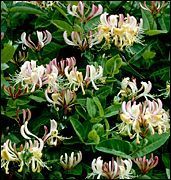Whether you accept it, avoid it or live somewhere in between, insurance coverage has become a defining issue for our profession. Patients increasingly expect to use their benefits, practitioners want to be compensated fairly for their time and expertise, and the system itself remains – at best – fragmented. The encouraging news is that coverage has expanded in meaningful ways. The challenging news is that reimbursement, across the board, remains inadequate.
Herbs & Botanicals
Honeysuckle Flower (jin yin hua)
What is honeysuckle flower? What is it used for?
There are approximately 200 species of honeysuckle that grow worldwide, all of which belong to the genus Lonicera, of the family Caprifoliaceae. Although they are usually found in the temperate zones, honeysuckle has also been known to grow in the Himalayas and southern Asia.
The Japanese honeysuckle (Lonicera japonica) is used in traditional Chinese medicine, and will be discussed in this article. It has fragrant, yellow-white flowers and black berries.
Different parts of the honeysuckle are used to treat different conditions. This article discusses the properties of honeysuckle flower; honeysuckle stem is discussed in a related article. The flower buds are gathered in the beginning of summer, then dried in the shade before being used in herbal remedies. They can be used raw, or after being fried or distilled.
 In traditional Chinese medicine, honeysuckle flower has sweet and cold properties, and is associated with the Lung, Stomach and Large Intestine meridians. It is used to clear heat and remove toxins. Generally, honeysuckle flower has been employed to treat a variety of conditions, ranging from fevers, ulcers, inflammation and sore throats to skin infections. It is also used (in conjunction with coptis and pulsatilla) to treat diarrhea caused by toxic heat. Honeysuckle flower may be applied internally or externally.
In traditional Chinese medicine, honeysuckle flower has sweet and cold properties, and is associated with the Lung, Stomach and Large Intestine meridians. It is used to clear heat and remove toxins. Generally, honeysuckle flower has been employed to treat a variety of conditions, ranging from fevers, ulcers, inflammation and sore throats to skin infections. It is also used (in conjunction with coptis and pulsatilla) to treat diarrhea caused by toxic heat. Honeysuckle flower may be applied internally or externally.
How much honeysuckle flower should I take?
The typical dose of honeysuckle flower is between 6 and 15 grams, decocted for oral administration, depending on the condition being treated. Larger doses can be used when the herb is applied to the skin.
What forms of honeysuckle flower are available?
Dried honeysuckle flower can be found at many Asian markets and specialty stores. Some stores also sell honeysuckle decoctions, infusions and powders.
What can happen if I take too much honeysuckle flower? Are there any interactions I should be aware of? What precautions should I take?
Honeysuckle flower should be given with caution to patients diagnosed with cold in the stomach and spleen, or to patients with yin-related skin disorders. In addition, the leaves and stems of honeysuckle contain substances called saponins, which are poorly absorbed by the human body but can be dangerous if taken in extreme amounts. As of this writing, there are no known drug interactions with honeysuckle flower. As always, make sure to consult with a licensed health care provider before taking honeysuckle flower or any other herbal remedy or dietary supplement.
References
- Editorial Committee of Chinese Materia Medica. State Drug Administration of China. Chinese Materia Medica. Shanghai: Science and Techonology Press, 1998.
- Fan JQ, et al. Guangzhou Journal of Medicine 1998;29(3):59-62.
- Long SJ, et al. Journal of Chinese Materia Medica 1999;30(1):40-43.
- Wang SP, et al. Journal of Popular Medicine of Chinese Ethnic Minorities 1998;(5):40-41.
- Yang L. Zhejiang Journal of Traditional Chinese Medicine 1998;33(6):282.


